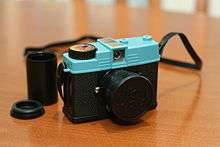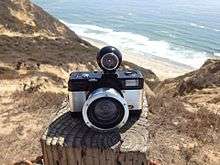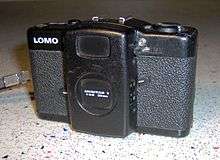Lomography
Lomography is a commercial trademark of Lomographische AG, which their creators associate to a photographic image style and an film camera movement and community facilitated by The Lomographic Society International.
The Lomographic Society International was founded in 1992 by a group of Viennese students after they discovered the LCA, a camera created by LOMO PLC of Saint Petersburg, Russia.[1][2][3] Lomography started as an art movement through which the students put on exhibitions of photos within Vienna; the art movement then developed into a commercial enterprise. Since 1995, Lomography has been the sole distributor of the LC-A camera outside the former Soviet Union, and has moved into producing their own range of analog cameras, films and accessories.
History
| Alternative photography |
|---|
 |
The lomography name is inspired by the former state-run optics manufacturer LOMO PLC of Saint Petersburg, Russia that created and produced the 35 mm LOMO LC-A Compact Automat camera, now central to lomography. This camera was loosely based upon the Cosina CX-1 and introduced in the early 1980s.[4]
Lomography also represents the commercial trademark of Lomographische AG, an Austrian company that produces cameras and accessories. The society is headquartered in Vienna, Austria.

In 1991, a group of Viennese students discovered the LOMO LC-A and were inspired by its "unique, colorful, and sometimes blurry" images.[5] The Lomographic Society International was subsequently founded in 1992.[6] After a series of art exhibitions culminating in shows in New York City and Moscow,[6] Lomography signed an exclusive distribution agreement with LOMO PLC in 1995 — becoming the sole distributor of all LOMO LC-A cameras outside of the former Soviet Union.[7] The new company reached an agreement with the deputy mayor of St Petersburg, the future Russian Prime Minister and President, Vladimir Putin, to receive a tax break in order to keep the LOMO factory in the city open.[6]
Since the introduction of the original LOMO LC-A, Lomography has produced a line of their own film cameras. In 2005, production of the original LOMO LC-A was discontinued. Its replacement, the LOMO LC-A+, was introduced in 2006. The new camera, made in China rather than Russia, featured the original Russian lens manufactured by LOMO PLC.[8] This changed as of mid-2007 with the lens now made in China as well. In 2012 the LC-A+ camera was re-released as a special edition.[9]
Lomography has also released products catered to digital devices, such as the Smartphone Film Scanner;[10] and the Achromat lens collection[11] for SLR cameras with Canon EF, Nikon F or Pentax K mounts, inspired by 19th century Daguerreotype photography.
In 2013, together with Zenit, Lomography produced a new version of the Petzval Lens designed to work with Canon EF and Nikon F mount SLR cameras.
Models


Cameras that have been marketed by Lomographische AG:
- LOMO LC-A+[6]
- LC-A 120[12][13]
- Diana F+[1]
- Spinner 360°
- Sprocket Rocket
- Actionsampler
- Pop-9
- Oktomat
- Fisheye
- Fisheye 2
- Colorsplash
- Colorsplash Flash
- SuperSampler
- La Sardina
- LomoKino - a 35 mm analog movie camera
- Diana Baby - 110 film
- Fisheye Baby - 110 film
- Konstruktor - a build-it-yourself 35 mm SLR camera
- Fritz the Blitz
Film
The company produces several kinds of 35 mm, 120 and 110 film.
Publication
- Holga: the World Through a Plastic Lens. Vienna: Lomographic Society International, 2006. By Adam Scott and Lomographic Society International. ISBN 3-902217-07-3. Paperback edition.
Lomographic aesthetic
The stated philosophy of Lomography is summarized in its motto, "Don’t Think, Just Shoot."[6] This motto is accompanied by The Ten Golden Rules which are supposed to encourage spontaneity and the taking of photographs anywhere, while minimizing considerations of formal technique.[14] Typical Lomography cameras are deliberately low-fidelity and of simple construction. Some cameras make use of multiple lenses and rainbow-colored flashes; some exhibit extreme optical distortions and light leaks.[15] The intention of the lomographic style is one of acceptance of such deficiencies in order to create images with a unique character. Most camera phone photo editor apps include a "lomo" filter, the exact mechanisms of which vary by app.
Typical of lomography are images with high contrast and with unusual saturation and color that were created using the technique called cross processing in which film intended for developing in slide chemistry (E-6) is processed in photographic negative chemistry (C-41), and vice versa. This technique can be employed with any film camera and can be somewhat mimicked with photo-editing software such as GIMP or Photoshop.
Community
The Lomographic Society International runs Lomography Gallery Stores and so-called "embassies" dedicated to the growth, support and public exposure of analogue photography. Customers interact through social events such as exhibits and workshops.
An example of the society's events showing peoples' lomography talents is the Lomokikuyu competition, which raises money for charity.[16]
The organisation organises the Lomography World Congress, an international conference.
The Lomographic Society International maintains a community website featuring lomographic photographs.[17]
Photo gallery
 A Fisheye 2 with a fisheye viewfinder
A Fisheye 2 with a fisheye viewfinder A 1988 LOMO LC-A camera
A 1988 LOMO LC-A camera Fisheye-lens photo of Wakayama Castle
Fisheye-lens photo of Wakayama Castle The view of buildings in Downtown Los Angeles through the Fisheye 2 camera.
The view of buildings in Downtown Los Angeles through the Fisheye 2 camera.
References
- 1 2 "How An Analog Photo Company Can Thrive In An Instagram Age". Fast Company. 11 August 2015. Retrieved 2018-05-10.
- ↑ Dowling, Stephen (22 November 2012). "Did the Lomo camera save film photography?". BBC News. Retrieved 2018-05-10 – via www.bbc.co.uk.
- ↑ "History · Lomography". Lomographische AG.
- ↑ "LOMO LC-A's Father: The Cosina CX-2". Lomographische AG. 2 August 2011. Retrieved 26 May 2012.
- ↑ Drake, James (12 June 2000). "A Camera That Really Opens Your Eyes". Bloomberg Businessweek. Retrieved 26 May 2012.
- 1 2 3 4 5 Blenford, Adam (22 September 2007). "Lomos: New take on an old classic". BBC News. Retrieved 26 May 2012.
- ↑ "A guide to Lomography". ePhotozine. 2 August 2002. Retrieved 26 May 2012.
- ↑ "Timeline". Lomographische AG. Retrieved 30 May 2012.
- ↑ "Lomography LC-A+ 20th Anniversary Edition". Hypebeast. Retrieved 2017-03-22.
- ↑ "The Lomography Smartphone Film Scanner". Hypebeast. Retrieved 2017-03-22.
- ↑ "Lomography Bridges Technology With the Past by Recreating the First Photographic Optic Lens". HYPEBEAST. Retrieved 2017-03-22.
- ↑ "Film isn't dead! The Lomo LC-A 120 helps fuel the retro revival". TechRadar. Retrieved 2018-05-10.
- ↑ "Lomography LC-A 120". PCMag UK. 7 May 2015. Retrieved 2018-05-10.
- ↑ "The Ten Golden Rules". Lomographische AG. Retrieved 26 May 2012.
- ↑ "Niche Photography". Apple Daily (in Chinese). 28 April 2009. Retrieved 26 May 2012.
- ↑ "Lomokikyu". Lomographische AG. Retrieved 26 May 2012.
- ↑ Plummer, Libby (3 March 2011). "Lomography – the return of analogue". Pocket-Lint. Retrieved 26 May 2012.
External links
| Wikimedia Commons has media related to Lomography. |